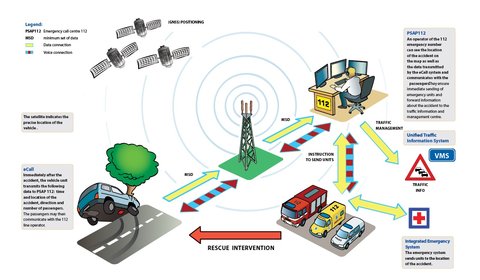
19/04/2017
Real-time road assistance with e-Call
Paolo Ferrini
Starting next year, all newly registered vehicles must be equipped with an on-board e-Call service device. A system that will significantly improve road safety (a 10% reduction in the number of road accident victims per year is hoped for), and one that aftermarket specialists would do well to become familiar with.
A tow truck unloading a badly damaged car or simply one that was stranded on the road in a workshop is a fairly common sight for those working in a repair shop or in a body shop. Sometimes, however, the driver, injured during the event, or for some other reason unable to follow his vehicle will not be present. And far too many times this is the case. Not to mention occasions when the driver is unable to pick up the phone and call an emergency number. More often than not, few seconds can make the difference between life and death.
To overcome this problem, the European Parliament has recently established that, beginning in March 31, 2018 all newly registered cars and light commercial vehicles must be equipped with mandatory e-Call devices, an automatic emergency call system. Such provision, though, will not be mandatory on vehicles already registered. Furthermore, the European Parliament is also investigating the possibility of an extension of the measure to buses, coaches and trucks. Such service will be free of charge on all vehicles, while privacy issues have been overcome as the device will not be traceable before an accident and sensitive data will be erased.
The project follows the same path already set, in North America, by OnStar (General Motors) and other similar systems offered with slight differences from a number of insurance companies (think, for example, of Allianz “Sixth sense” assistance service) as well as by some manufacturers such as BMW, Chevrolet, Ford and Lexus, in which a “black box” installed on a vehicle is able to collect and transmit the data gathered from air-bag and crush sensors to local emergency agencies along with the vehicle’s coordinates obtained through the Galileo tracking system.
But what exactly is an e-Call device? And above all, how does it works? In a nutshell, let us say that in the event of a serious accident, the system, alerted by the same sensors that actuate the airbags, automatically sends an emergency call from the vehicle to the single European emergency telephone number 112 so that, if the people involved are unconscious or cannot move, emergency assistance agencies will immediately go into action.
Once information about the emergency is obtained, the e-Call service center coordinates immediately the operations sending on-site the appropriate staff, making it possible to reduce rescue time after a road accident.
Unlike other systems in which the driver is required to press a button, here is the vehicle itself that sends out the exact GPS position along with other data such as the chassis number to the operations center. At the same time the nearest police station and emergency agency is identified and a voice connection made with the possible victims. If not possible, the staff will immediately inform the rescue teams. According to the producers of these devices, this technology will halve the response time of emergency services in rural areas and reduce by as much as 40% the response time in urban areas.
In 2014, EU road accidents have cost the lives of 25,700 people, a figure that, thanks to the installation of these new devices, could be reduced, according to estimates, by about 10% every year. "The use of the 112-based e-Call emergency system across the EU will make a great contribution in improving road safety in all Member States", said the supervisor of the draft regulation, the Czech MEP Olga Sehnalová. "The European Parliament has repeatedly pointed out that the reduction of fatalities and serious injuries on the roads is a priority. The use of e-Call systems as a public service will contribute to this common objective".
To overcome this problem, the European Parliament has recently established that, beginning in March 31, 2018 all newly registered cars and light commercial vehicles must be equipped with mandatory e-Call devices, an automatic emergency call system. Such provision, though, will not be mandatory on vehicles already registered. Furthermore, the European Parliament is also investigating the possibility of an extension of the measure to buses, coaches and trucks. Such service will be free of charge on all vehicles, while privacy issues have been overcome as the device will not be traceable before an accident and sensitive data will be erased.
The project follows the same path already set, in North America, by OnStar (General Motors) and other similar systems offered with slight differences from a number of insurance companies (think, for example, of Allianz “Sixth sense” assistance service) as well as by some manufacturers such as BMW, Chevrolet, Ford and Lexus, in which a “black box” installed on a vehicle is able to collect and transmit the data gathered from air-bag and crush sensors to local emergency agencies along with the vehicle’s coordinates obtained through the Galileo tracking system.
But what exactly is an e-Call device? And above all, how does it works? In a nutshell, let us say that in the event of a serious accident, the system, alerted by the same sensors that actuate the airbags, automatically sends an emergency call from the vehicle to the single European emergency telephone number 112 so that, if the people involved are unconscious or cannot move, emergency assistance agencies will immediately go into action.
Once information about the emergency is obtained, the e-Call service center coordinates immediately the operations sending on-site the appropriate staff, making it possible to reduce rescue time after a road accident.
Unlike other systems in which the driver is required to press a button, here is the vehicle itself that sends out the exact GPS position along with other data such as the chassis number to the operations center. At the same time the nearest police station and emergency agency is identified and a voice connection made with the possible victims. If not possible, the staff will immediately inform the rescue teams. According to the producers of these devices, this technology will halve the response time of emergency services in rural areas and reduce by as much as 40% the response time in urban areas.
In 2014, EU road accidents have cost the lives of 25,700 people, a figure that, thanks to the installation of these new devices, could be reduced, according to estimates, by about 10% every year. "The use of the 112-based e-Call emergency system across the EU will make a great contribution in improving road safety in all Member States", said the supervisor of the draft regulation, the Czech MEP Olga Sehnalová. "The European Parliament has repeatedly pointed out that the reduction of fatalities and serious injuries on the roads is a priority. The use of e-Call systems as a public service will contribute to this common objective".






